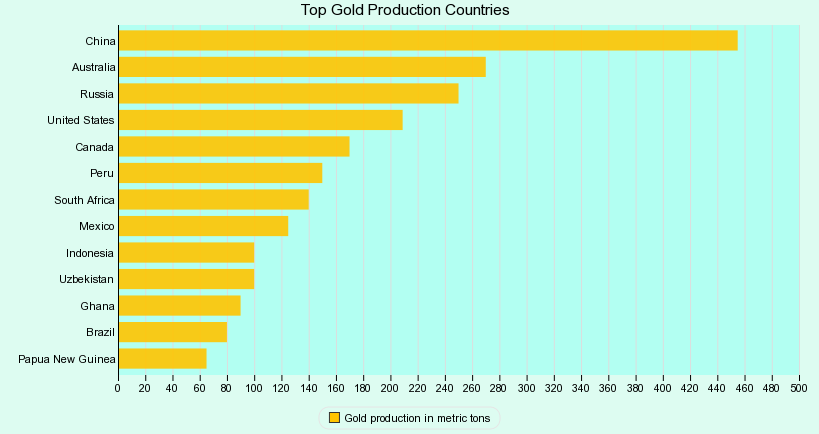This chart shows Top Gold Production Countries in the world.
Gold is a chemical element with symbol Au and atomic number 79. In its purest form, it is a bright, slightly reddish yellow, dense, soft, malleable, and ductile metal. Chemically, gold is a transition metal and a group 11 element. It is one of the least reactive chemical elements and is solid under standard conditions. Gold often occurs in free elemental form, as nuggets or grains, in rocks, in veins, and in alluvial deposits.
Gold is thought to have been produced in supernova nucleosynthesis, from the collision of neutron stars, and to have been present in the dust from which the Solar System formed. Because the Earth was molten when it was formed, almost all of the gold present in the early Earth probably sank into the planetary core.
Gold is resistant to most acids, though it does dissolve in aqua regia, a mixture of nitric acid and hydrochloric acid, which forms a soluble tetrachloroaurate anion. Gold is insoluble in nitric acid, which dissolves silver and base metals, a property that has long been used to refine gold and to confirm the presence of gold in metallic objects, giving rise to the term acid test.
Gold also dissolves in alkaline solutions of cyanide, which are used in mining and electroplating. Gold dissolves in mercury, forming amalgam alloys, but this is not a chemical reaction.
A total of 186,700 tonnes of gold exists above ground, as of 2015. The world consumption of new gold produced is about 50% in jewelry, 40% in investments, and 10% in industry.Gold's high malleability, ductility, resistance to corrosion and most other chemical reactions, and conductivity of electricity have led to its continued use in corrosion resistant electrical connectors in all types of computerized devices.
Gold is also used in infrared shielding, colored-glass production, gold leafing, and tooth restoration. Certain gold salts are still used as anti-inflammatories in medicine. As of 2014, the world's largest gold producer by far was China with 450 tonnes.
Gold is the most malleable of all metals; a single gram can be beaten into a sheet of 1 square meter, and an avoirdupois ounce into 300 square feet. Gold leaf can be beaten thin enough to become semi-transparent. The transmitted light appears greenish blue, because gold strongly reflects yellow and red.
8 years ago

